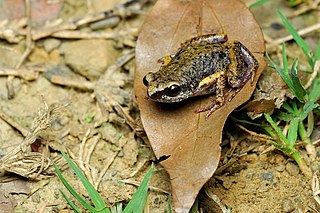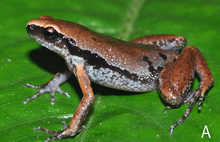
A frog is any member of a diverse and largely carnivorous group of short-bodied, tailless amphibians composing the order Anura. The oldest fossil "proto-frog" Triadobatrachus is known from the Early Triassic of Madagascar, but molecular clock dating suggests their split from other amphibians may extend further back to the Permian, 265 million years ago. Frogs are widely distributed, ranging from the tropics to subarctic regions, but the greatest concentration of species diversity is in tropical rainforest. Frogs account for around 88% of extant amphibian species. They are also one of the five most diverse vertebrate orders. Warty frog species tend to be called toads, but the distinction between frogs and toads is informal, not from taxonomy or evolutionary history.

True frogs is the common name for the frog family Ranidae. They have the widest distribution of any frog family. They are abundant throughout most of the world, occurring on all continents except Antarctica. The true frogs are present in North America, northern South America, Europe, Africa, and Asia. The Asian range extends across the East Indies to New Guinea and a single species, the Australian wood frog, has spread into the far north of Australia.

Sooglossidae, the Seychelles frogs or Seychelles Island frogs, are a family of frogs found on the Seychelles Islands. Until recently, this family was believed to include the genera Sechellophryne, Nesomantis and Sooglossus, but following a major revision of amphibians in 2006, the genus Nesomantis was named a junior synonym of Sooglossus. Their closest relatives are the purple frogs (Nasikabatrachidae) of India.

The Microhylidae, commonly known as narrow-mouthed frogs, are a geographically widespread family of frogs. The 683 species are in 57 genera and 11 subfamilies.

Heleophrynidae is a family of frogs, commonly known as ghost frogs. They are thought to be the most basal group in the Neobatrachia. The family consists of two genera, Heleophryne and Hadromophryne, with seven species. Ghost frogs live in swift-moving mountain streams in South Africa. The common name of "ghost frogs" may have been coined because of their occurrence in Skeleton Gorge.

Pseudacris is a genus of frogs in the family Hylidae found in North America ranging from the Pacific coastline to the Atlantic.

Atelopus is a large genus of Bufonidae, commonly known as harlequin frogs or toads, from Central and South America, ranging as far north as Costa Rica and as far south as Bolivia. Atelopus species are small, generally brightly colored, and diurnal. Most species are associated with mid-to-high elevation streams.

A true toad is any member of the family Bufonidae, in the order Anura. This is the only family of anurans in which all members are known as toads, although some may be called frogs. The bufonids now comprise more than 35 genera, Bufo being the best known.

The Microhylinae are a subfamily of microhylid frogs. It contains 9 genera. Phylogenetic studies have estimated the family Microhylidae to be about 52 million years old.
Hoplophryne is a genus of microhylid frogs. The genus is endemic to mountain forests of Tanzania. They are also known as three-fingered frogs or African banana frogs.

Geocrinia is a genus of frogs in the family Myobatrachidae. These frogs are endemic to Australia. Two species are known from southeastern Australia, while one is known from southeastern Western Australia.

Myobatrachidae, commonly known as Australian ground frogs or Australian water frogs, is a family of frogs found in Australia and New Guinea. Members of this family vary greatly in size, from species less than 1.5 cm (0.59 in) long, to the second-largest frog in Australia, the giant barred frog, at 12 cm (4.7 in) in length. The entire family is either terrestrial or aquatic frogs, with no arboreal species.

Micryletta inornata is a rare species of frog in the family Microhylidae. It is endemic to the island of Sumatra in Indonesia, and is the type species for the genus Micryletta.

The forest rain frog is a species of frog in the family Brevicipitidae. It is endemic to Limpopo, South Africa. Two allopatric subspecies are recognized: the nominate one, Breviceps sylvestris sylvestris, and Breviceps sylvestris taeniatusPoynton, 1963 from near Soutpansberg. Its natural habitats are temperate forests, temperate grassland, and rural gardens. It is threatened by habitat loss.

Micryletta erythropoda, commonly known as the Mada paddy frog, is a species of frog in the family Microhylidae. It is known from Myanmar, Thailand, and Vietnam. Its natural habitats are swamps, freshwater marshes, and intermittent freshwater marshes. While formerly classified in the genus Microhyla, a 2018 study found it to belong to the genus Micryletta instead. A study performed in 2019 found that several Micryletta populations in southern Myanmar and Thailand that were formerly assigned to M. inornata actually belong to M. erythropoda; prior to this, M. erythropoda was considered endemic to Vietnam.

Micryletta steinegeri is a species of frog in the family Microhylidae. It is endemic to central and southern Taiwan. In the past it has also been considered as a synonym of Micryletta inornata from continental Asia.

The Pyxicephalidae are a family of frogs currently found in sub-Saharan Africa. However, in the Eocene, the taxon Thaumastosaurus lived in Europe.

The Strabomantidae are a family of frogs native to South America. These frogs lack a free-living larval stage and hatch directly into miniature "froglets". This family includes Pristimantis, the most speciose genus of any vertebrate.

Hylarana, commonly known as golden-backed frogs, is a genus of true frogs found in tropical Asia. It was formerly considered highly diverse, containing around 84 to 96 valid species, but taxonomic revision resulted in a major change in the contents of the genus, and today it is recognised as containing just four species.

Franky's narrow-mouthed frog is a species of frog in the family Microhylidae. It is the only member of the monotypic genus Mysticellus, the mysterious narrow-mouthed frogs. It is endemic to the Western Ghats of India, where it is only known from Wayanad District in northern Kerala state. Taxonomic evidence indicates that its closest relatives are the Micryletta frogs of Southeast Asia.



















